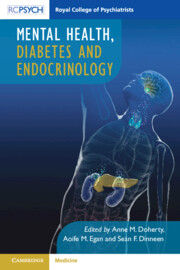Book contents
- Mental Health, Diabetes and Endocrinology
- Mental Health, Diabetes and Endocrinology
- Copyright page
- Contents
- Contributors
- Preface
- Chapter 1 An Introduction to Psychiatry in Endocrinology
- Chapter 2 Depression across Endocrine Disorders
- Chapter 3 Antipsychotic Medications and Metabolic Syndrome
- Chapter 4 ‘Diabulimia’, Diabetes and Eating Disorders
- Chapter 5 Disorders of the Hypothalamic–Pituitary–Adrenal Axis
- Chapter 6 Disorders of the Thyroid and Parathyroid
- Chapter 7 Psychological Factors Impacting on Endocrine Disorders and Self-Management and Medication-Taking Behaviour
- Chapter 8 Cognitive Impairment and Endocrine Conditions
- Chapter 9 Suicidal Ideation and Self-Harm
- Chapter 10 Obesity and Mental Health
- Chapter 11 Gender Incongruence
- Chapter 12 Anti-androgens in Forensic Psychiatric Settings
- Chapter 13 Service- and Setting-Related Challenges
- Index
- References
Chapter 5 - Disorders of the Hypothalamic–Pituitary–Adrenal Axis
Cushing’s Syndrome and Beyond
Published online by Cambridge University Press: 14 October 2021
- Mental Health, Diabetes and Endocrinology
- Mental Health, Diabetes and Endocrinology
- Copyright page
- Contents
- Contributors
- Preface
- Chapter 1 An Introduction to Psychiatry in Endocrinology
- Chapter 2 Depression across Endocrine Disorders
- Chapter 3 Antipsychotic Medications and Metabolic Syndrome
- Chapter 4 ‘Diabulimia’, Diabetes and Eating Disorders
- Chapter 5 Disorders of the Hypothalamic–Pituitary–Adrenal Axis
- Chapter 6 Disorders of the Thyroid and Parathyroid
- Chapter 7 Psychological Factors Impacting on Endocrine Disorders and Self-Management and Medication-Taking Behaviour
- Chapter 8 Cognitive Impairment and Endocrine Conditions
- Chapter 9 Suicidal Ideation and Self-Harm
- Chapter 10 Obesity and Mental Health
- Chapter 11 Gender Incongruence
- Chapter 12 Anti-androgens in Forensic Psychiatric Settings
- Chapter 13 Service- and Setting-Related Challenges
- Index
- References
Summary
The primary endocrine effectors of the stress response are located in the paraventricular nucleus of the hypothalamus, the anterior lobe of the pituitary gland and the adrenal gland. These structures are referred to as the hypothalamic–pituitary–adrenal (HPA) axis. In the setting of stress, corticotrophin-releasing factor induces the release of adrenocorticotropic hormone, which stimulates the synthesis and secretion of glucocorticoids from the adrenal gland. Glucocorticoids exert a wide range of effects and can influence cardiovascular function, immunity and inflammation, metabolism, reproduction and fluid volume. An important target organ is the brain, where glucocorticoids can affect neuronal differentiation and excitability, behavioral reactivity, mood and cognition. This regulatory system works in conjunction with the sympatho-adrenal medullary system, which releases catecholamines, including noradrenaline and adrenaline. These systems are crucial for dealing with both physiological and psychological stress and restoring our steady state. Inappropriate regulation of the stress response has been linked to a wide array of pathologies, including hypertension, diabetes, osteoporosis and psychological disorders. In this chapter, we will focus on disorders of the HPA axis and their effects on mental health.
- Type
- Chapter
- Information
- Mental Health, Diabetes and Endocrinology , pp. 43 - 55Publisher: Cambridge University PressPrint publication year: 2021



